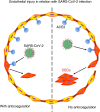Curative anticoagulation prevents endothelial lesion in COVID-19 patients
- PMID: 32558198
- PMCID: PMC7323356
- DOI: 10.1111/jth.14968
Curative anticoagulation prevents endothelial lesion in COVID-19 patients
Abstract
Background: Coronavirus disease-2019 (COVID-19) has been associated with cardiovascular complications and coagulation disorders.
Objectives: To explore the coagulopathy and endothelial dysfunction in COVID-19 patients.
Methods: The study analyzed clinical and biological profiles of patients with suspected COVID-19 infection at admission, including hemostasis tests and quantification of circulating endothelial cells (CECs).
Results: Among 96 consecutive COVID-19-suspected patients fulfilling criteria for hospitalization, 66 were tested positive for SARS-CoV-2. COVID-19-positive patients were more likely to present with fever (P = .02), cough (P = .03), and pneumonia at computed tomography (CT) scan (P = .002) at admission. Prevalence of D-dimer >500 ng/mL was higher in COVID-19-positive patients (74.2% versus 43.3%; P = .007). No sign of disseminated intravascular coagulation were identified. Adding D-dimers >500 ng/mL to gender and pneumonia at CT scan in receiver operating characteristic curve analysis significantly increased area under the curve for COVID-19 diagnosis. COVID-19-positive patients had significantly more CECs at admission (P = .008) than COVID-19-negative ones. COVID-19-positive patients treated with curative anticoagulant prior to admission had fewer CECs (P = .02) than those without. Interestingly, patients treated with curative anticoagulation and angiotensin-converting-enzyme inhibitors or angiotensin receptor blockers had even fewer CECs (P = .007).
Conclusion: Curative anticoagulation could prevent COVID-19-associated coagulopathy and endothelial lesion.
Keywords: COVID-19; D-dimers; SARS-CoV-2; circulating endothelial cells; coagulopathy.
© 2020 International Society on Thrombosis and Haemostasis.
Figures



References
-
- Wu Z., McGoogan J.M. Characteristics of and important lessons from the coronavirus disease 2019 (COVID‐19) outbreak in China. JAMA. 2020;323(13):1239. - PubMed
Publication types
MeSH terms
Substances
LinkOut - more resources
Full Text Sources
Medical
Miscellaneous

